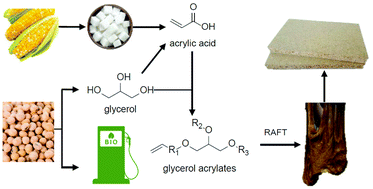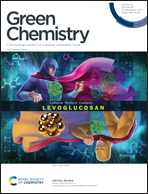RAFT thermoplastics from glycerol: a biopolymer for development of sustainable wood adhesives†
Abstract
The increasing demand for bioderived plastics and rubbers and the large supply of glycerol makes it an excellent starting chemical for the production of biopolymers. Little success in commercially viable glycerol polymers has yet to be realized. In particular, high molecular weight thermoplastics have been especially elusive due to the multifunctional nature of glycerol. This work details the production of glycerol–acrylic biopolymers. By esterifying glycerol with acrylic acid, and subsequent RAFT polymerization to suppress the gelation, we were able to achieve glycerol thermoplastics with high molecular weights (1 MDa). After studying the thermal/mechanical properties of the polymer, it was found that these glycerol polymers had a high degree of tack. When added to wood as an adhesive, it was found that performance was comparable or exceeded standard wood adhesives such as Poly (Methylene diphenyl diisocyanate) (PMDI) and formaldehyde based adhesives. This yields wood adhesives that have less toxicity, lower environmental impact, and higher renewability.



 Please wait while we load your content...
Please wait while we load your content...